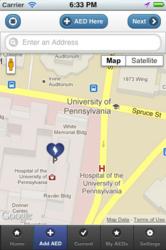
Philadelphia, PA (PRWEB) February 08, 2012
Azavea, an award-winning geospatial analysis (GIS) software development company, announces a crowd-sourcing contest to locate automated external defibrillators (AED) and the release of a web application and two free mobile apps, part of the Perelman School of Medicine at the University of Pennsylvanias MyHeartMap Challenge. The applications are now available for the public to participate in the MyHeartMap Challenge which will run for six weeks from January 31 to Tuesday, March 13. In an effort to build a national database of AEDs and increase AED awareness, the Penn Medicines MyHeartMap is turning to the public to gather as much information as possible about AEDs accessible to the public.
Though almost non-existent a decade ago, automatic external defibrillators (AEDs) are now all around us, in airports, schools, gyms, and workplaces. These devices can save lives as they deliver electric shocks to victims of cardiac arrests. This is most effective in the first minutes after someone collapses. Yet, there is no comprehensive map of such devices available to the public. As a result, AEDs are often not used when they are most needed either because witnesses of a cardiac arrest incident do not know there might be an AED close by or that they should be looking for one.
The Penn Medicine MyHeartMap team is initiating the MyHeartMap Challenge project by encouraging the public, armed with the web and mobile applications built by Azavea, to locate and photograph as many AEDs in Philadelphia as possible. Both the apps and participation in the contest are free. Participants will be able to geocode their photos via the mobile app available on the iPhone or Android — and register information about the AEDs such as manufacturer and condition of the device. In addition to the mobile apps, participants can enter data and check their status in the contest at the MyHeartMap website: http://philly.myheartmap.org/.
MyHeartMap Challenge participants can register as individuals or as teams. The individual or team that will find the most AEDs will win $ 10,000. Other participants will win $ 50 if they are the first to identify one of the designated golden AEDs. The MyHeartMap team is being coy about the precise number of golden AEDs, but has announced that there will be 20 to 200 of them. The data collected will be used to create an updated database of locations of all public AEDs in the Philadelphia region with a person’s GPS coordinates to help them locate the nearest AED during an emergency. The project is part of a larger ongoing collaboration between faculty of the University of Pennsylvania and the University of Washington and is modeled after the DARPA Network Challenge, a crowd-sourcing experiment in which social media users raced to be the first to submit the locations of 10 moored, 8-foot, red, weather balloons at 10 fixed locations throughout the United States. It is the teams hope that this challenge will lead to a nation-wide contest.
The MyHeartMap Challenge project is funded by the Robert Wood Johnson Foundation; Physio Control; the Medtronic Foundation; the HeartRescue Project; Zoll; Cardiac Science; Philips and the University of Pennsylvania.
For more information about the MyHeartMap Challenge, visit: http://www.myheartmap.org. Participants can use a web application available at: http://philly.myheartmap.org/ The smart phone apps can also be downloaded for free for the iPhone at http://itunes.apple.com/app/id492442372?mt=8 and from the Android Marketplace at https://market.android.com/details?id=edu.upenn.medicine.myheartmap.
About Azavea – Azavea is an award-winning geospatial analysis (GIS) software development firm specializing in the creation of location-based web and mobile software as well as geospatial analysis services. Azavea is a certified B Corporation that applies geographic data and technology to promote the emergence of more dynamic, vibrant, and sustainable communities. Each of Azaveas projects, products and pro bono engagements showcases this commitment. Find more at http://www.azavea.com.
If you would like more information about Azavea or to schedule an interview with Robert Cheetham, Azavea CEO and President, please contact Amy Trahey at (215) 558 6184 or e-mail atrahey(at)azavea(dot)com.
About MyHeartMap Challenge The Philadelphia MyHeartMap Challenge is the first of many city Challenges, followed by a nation-wide contest. Data collected for the contest will be used for a U-Penn research study evaluating AED mapping and database development. It is the initiative of a group of health professionals dedicated to saving lives and expanding the horizons of theory and practicethis interdisciplinary team has come together to engage and challenge the Philadelphia community to improve access to critical life-saving technologies. By harnessing the increasing reach of new media they hope to bring innovation to address an important public health disparity. Find more at http://www.myheartmap.org
For more information about the MyHeartMap Challenge, contact the team at myheartmapchallenge(at)uphs(dot)upenn(dot)edu
###

